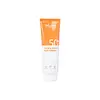What's inside
What's inside
 Key Ingredients
Key Ingredients

 Benefits
Benefits

 Concerns
Concerns

 Ingredients Side-by-side
Ingredients Side-by-side

Water
Skin ConditioningEthylhexyl Methoxycinnamate
UV AbsorberTitanium Dioxide
Cosmetic ColorantDiglycerin
HumectantEthylhexyl Salicylate
UV AbsorberDimethicone
EmollientIsohexadecane
EmollientLauryl PEG-9 Polydimethylsiloxyethyl Dimethicone
Skin ConditioningCyclopentasiloxane
EmollientCyclotetrasiloxane
EmollientMagnesium Sulfate
Dimethicone/PEG-10/15 Crosspolymer
Triethoxycaprylylsilane
Caprylyl Glycol
EmollientCanola Oil
EmollientZea Mays Oil
EmulsifyingPhenoxyethanol
PreservativeChlorphenesin
AntimicrobialWater, Ethylhexyl Methoxycinnamate, Titanium Dioxide, Diglycerin, Ethylhexyl Salicylate, Dimethicone, Isohexadecane, Lauryl PEG-9 Polydimethylsiloxyethyl Dimethicone, Cyclopentasiloxane, Cyclotetrasiloxane, Magnesium Sulfate, Dimethicone/PEG-10/15 Crosspolymer, Triethoxycaprylylsilane, Caprylyl Glycol, Canola Oil, Zea Mays Oil, Phenoxyethanol, Chlorphenesin
Water
Skin ConditioningCyclopentasiloxane
EmollientEthylhexyl Methoxycinnamate
UV AbsorberEthylhexyl Salicylate
UV AbsorberGlycerin
HumectantZinc Oxide
Cosmetic ColorantPEG-10 Dimethicone
Skin ConditioningCI 77891
Cosmetic ColorantDimethicone
EmollientDipropylene Glycol
HumectantPortulaca Oleracea Extract
Skin ConditioningMagnesium Sulfate
Disteardimonium Hectorite
StabilisingC30-45 Alkyl Cetearyl Dimethicone Crosspolymer
EmollientIsoamyl P-Methoxycinnamate
UV AbsorberVinyl Dimethicone/Methicone Silsesquioxane Crosspolymer
Aluminum Hydroxide
EmollientStearic Acid
CleansingButylene Glycol
HumectantCaffeine
Skin ConditioningDisodium EDTA
Phenoxyethanol
PreservativePotassium Sorbate
PreservativeParfum
MaskingBenzyl Benzoate
AntimicrobialButylphenyl Methylpropional
PerfumingGeraniol
PerfumingLinalool
PerfumingLimonene
PerfumingCitronellol
PerfumingAlpha-Isomethyl Ionone
PerfumingWater, Cyclopentasiloxane, Ethylhexyl Methoxycinnamate, Ethylhexyl Salicylate, Glycerin, Zinc Oxide, PEG-10 Dimethicone, CI 77891, Dimethicone, Dipropylene Glycol, Portulaca Oleracea Extract, Magnesium Sulfate, Disteardimonium Hectorite, C30-45 Alkyl Cetearyl Dimethicone Crosspolymer, Isoamyl P-Methoxycinnamate, Vinyl Dimethicone/Methicone Silsesquioxane Crosspolymer, Aluminum Hydroxide, Stearic Acid, Butylene Glycol, Caffeine, Disodium EDTA, Phenoxyethanol, Potassium Sorbate, Parfum, Benzyl Benzoate, Butylphenyl Methylpropional, Geraniol, Linalool, Limonene, Citronellol, Alpha-Isomethyl Ionone
 Reviews
Reviews

Ingredients Explained
These ingredients are found in both products.
Ingredients higher up in an ingredient list are typically present in a larger amount.
Cyclopentasiloxane, or D5, is a silicone used to improve texture of products and trap moisture.
D5 is considered lightweight and volatile. Volatile means it evaporates quickly after application. Once evaporated, D5 leaves a thin barrier that helps keep skin hydrated.
It is also an emollient. Emollients help soften the skin and prevent water loss. Silicones create a silky texture in products. D5 helps other ingredients become more spreadable.
Studies show D5 is safe to use in skincare products. We recommend speaking with a skincare professional if you have concerns.
Learn more about CyclopentasiloxaneDimethicone is a type of synthetic silicone created from natural materials such as quartz.
What it does:
Dimethicone comes in different viscosities:
Depending on the viscosity, dimethicone has different properties.
Ingredients lists don't always show which type is used, so we recommend reaching out to the brand if you have questions about the viscosity.
This ingredient is unlikely to cause irritation because it does not get absorbed into skin. However, people with silicone allergies should be careful about using this ingredient.
Note: Dimethicone may contribute to pilling. This is because it is not oil or water soluble, so pilling may occur when layered with products. When mixed with heavy oils in a formula, the outcome is also quite greasy.
Learn more about DimethiconeEthylhexyl Methoxycinnamate is an organic compound that provides UVB protection. It often goes by the more common name of octinoxate. It is created from methoxycinnamic acid and 2-ethylhexanol.
Ethylhexyl Methoxycinnamate absorbs UVB rays with wavelengths between 280-320 nm. UV absorbers protect your skin by using chemical reactions to convert UV rays into heat and energy.
UVB (290-320 nm) rays emit more energy than UVA rays. They are capable of damaging DNA, causing sunburns and are thought to be linked to skin cancer.
The state of Hawaii has banned sunscreens containing octinoxate due to its potential impact on coral reefs. More research is needed to bridge gaps in this research. The European Union allows higher levels of octinoxate in sunscreens than the US and Australia.
Ethylhexyl Methoxycinnamate is oil soluble. It is not stable and may lose efficacy when exposed to sunlight.
Learn more about Ethylhexyl MethoxycinnamateEthylhexyl Salicylate is an organic compound used to block UV rays. It primarily absorbs UVB rays but offers a small amount of UVA protection as well.
Commonly found in sunscreens, Ethylhexyl Salicylate is created from salicylic acid and 2-ethylhexanol. You might know salicylic acid as the effective acne fighter ingredient and BHA.
The ethylhexanol in this ingredient is a fatty alcohol and helps hydrate your skin, similar to oils. It is an emollient, which means it traps moisture into the skin.
According to manufacturers, Ethylhexyl Salicylate absorbs UV wavelength of 295-315 nm, with a peak absorption at 307-310 nm. UVA rays are linked to long term skin damage, such as hyperpigmentation. UVB rays emit more energy and are capable of damaging our DNA. UVB rays cause sunburn.
Learn more about Ethylhexyl SalicylateMagnesium Sulfate is a salt. More specifically, it is an epsom salt, or the bath salt used to help relieve muscle aches.
Despite having ‘sulfate’ in the name, it isn’t a surfactant or cleansing agent like sodium lauryl sulfate. Unlike those sulfates, magnesium sulfate doesn’t have the same cleansing or foaming properties (it's simply a type of salt).
In cosmetics, Magnesium Sulfate is used to thicken a product or help dilute other solids. It is a non-reactive and non-irritating ingredient.
One study shows magnesium deficiency may lead to inflammation of the skin. Applying magnesium topically may help reduce inflammation.
You can find this ingredient in sea water or mineral deposits.
Learn more about Magnesium SulfatePhenoxyethanol is a preservative that has germicide, antimicrobial, and aromatic properties. Studies show that phenoxyethanol can prevent microbial growth. By itself, it has a scent that is similar to that of a rose.
It's often used in formulations along with Caprylyl Glycol to preserve the shelf life of products.
Water. It's the most common cosmetic ingredient of all. You'll usually see it at the top of ingredient lists, meaning that it makes up the largest part of the product.
So why is it so popular? Water most often acts as a solvent - this means that it helps dissolve other ingredients into the formulation.
You'll also recognize water as that liquid we all need to stay alive. If you see this, drink a glass of water. Stay hydrated!
Learn more about Water